SIBLING RIVALRY
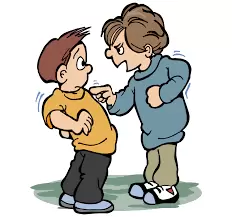
- If you have more than one child, expect sibling rivalry.
- Focus on the good things about having siblings.
- Teach your children that fair does not mean equal.
- Do not favor one child.
- Spend one-on-one time with each child.
- View each child as an individual. Do not compare.
- Teach skills to settle conflicts peacefully.
- Treat others how you want your children to treat each other.
- Only get involved in sibling problems when someone may get hurt.
- Have a home that values respect and understanding.
The following information can give you some guidelines about what might be an appropriate stance to take about when and how to intervene. Think of it as the “green light to red light” guideline.
With this in mind, you can think about what your children need from you when they engage in fighting with their siblings. That can help you decide if, when, or how to intervene.
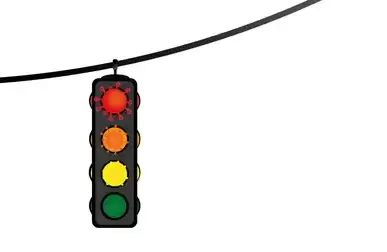
- Green light
Normal Bickering, minor name calling
Parent’s role – Stay out of it.
- Yellow light
Borderline, volume is going up, nasty name-calling, mild physical contact, threats of danger
Parent’s role – Acknowledge anger and reflect each child’s viewpoint.
- Orange light
Potential Danger, more serious, half play/half real fighting
Parent’s role – Inquire: “Is it play or real?” Firmly stop the interaction, review rules, and help with conflict resolution.
- Red light
Dangerous Situation, physical or emotional harm is about to or has occurred
Parent’s role– Firmly stop the children and separate them. If a child is hurt, attend to that child first, review the rules, and possibly impose a consequence.
Normal Bickering, minor name calling
Parent’s role – Stay out of it.
Borderline, volume is going up, nasty name-calling, mild physical contact, threats of danger
Parent’s role – Acknowledge anger and reflect each child’s viewpoint.
Potential Danger, more serious, half play/half real fighting
Parent’s role – Inquire: “Is it play or real?” Firmly stop the interaction, review rules, and help with conflict resolution.
Dangerous Situation, physical or emotional harm is about to or has occurred
Parent’s role– Firmly stop the children and separate them. If a child is hurt, attend to that child first, review the rules, and possibly impose a consequence.
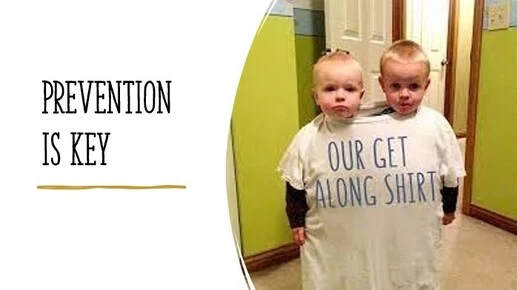
Avoid comparing your children with each other.
Give your time in terms of need. At times, your fifth grader may need your help with homework more than the youngest needs you to watch cartwheels; at other times, the youngest may need time and attention when she falls down doing her gymnastics.
Teach children to be assertive with words so they don’t rely on you to rescue them. Of course, keep your eyes and ears open in case things escalate and your presence is needed.
Be a positive role model by using healthy communication to resolve conflict.
Plan a daily routine with time apart and give each child his or her own “space.”
Help kids structure time and discover ways to be active and focused. Kids who have too much time on their hands often fill it by instigating a fight with their siblings.
When possible, arrange a special time or outing alone with each child (a walk, a visit to the park or library). Kids can learn to accept their sibling’s getting time with you if they know they will get a turn, too.
Be an observer to see if there is a pattern of conflict. For example, is there a particular time of day when struggles erupt, or is there a special toy over which your children consistently battle, or do arguments break out when one of your children has a friend visiting?
With this knowledge, you may be able to rearrange things to pre-empt the battles
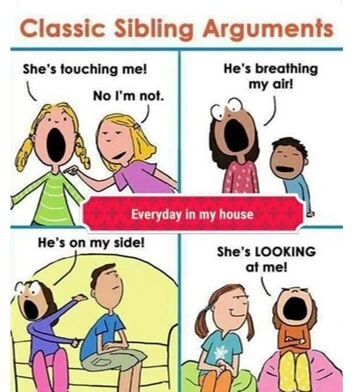
- Remove a toy children are fighting over.
- Separate children when they are fighting or teasing one another. For example, have them go to opposite sides of the room.
- Enforce logical consequences. For example, if they are fighting over who has control of the remote for the TV, the television gets turned off.
- Help children to express their feelings and to understand and empathise with the feelings of their siblings.
- Use time-outs, not to punish but to calm down and re-group.
- Give older children privileges as well as responsibilities.
- Help older children learn to ignore provocative behaviour of younger siblings.
- Make tattling unrewarding.
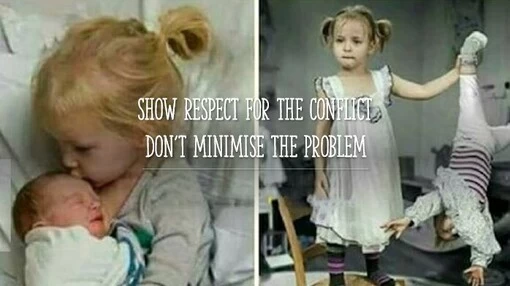
Show respect for the conflict. Don’t minimise the problem – When there’s ongoing conflict between kids, we get worn down. We just want it to go away. The battle over the TV remote may seem petty. children need practice resolving their “childish” disputes so they can peacefully resolve their adult disputes. A suggestion is “This is a difficult problem. Two children want to watch two different shows”.
– Resist the urge to take sides.
– Avoid the temptation to solve their problem for them
– But do – Remove the disputed object temporarily “I’ll put the remote on the shelf for now, while we figure out what to do. I bet if we put our heads together we can think of a solution that feels fair to both of you
Problem Exploration and Conflict Resolution
At first and when they are young, you will have to walk them through the whole process after each conflict. In time, they will be able to resolve their conflicts with their siblings and others on their own.
This process involves each child expressing his point of view and listening to the other child’s point of view, generating a number of possible solutions that work for each of them, choosing one solution, and trying it. e.g.“Hmm what can we do so that both of you get to see the show you like? Should we take turns? Should we make a schedule and have certain days for each person to decide? What do you guys think will work?
This skill helps your children to navigate relationships with peers and is useful throughout life. It makes them feel competent and capable as they see that they can come up with solutions to problems without fighting.
Remember that in order to engage in a problem exploration process, the children must be calm enough to dialogue. Time out may be called until both are calm enough to proceed.
You can model for your children when it comes to handling conflict:
- Use “fair fight” rules yourself.
- Use cool off times to calm down first; then re-enter the situation.
- Give second chances and opportunities to make amends.
e.g.“Hmm what can we do so that both of you get to see the show you like? Should we take turns? Should we make a schedule and have certain days for each person to decide? What do you guys think will work?
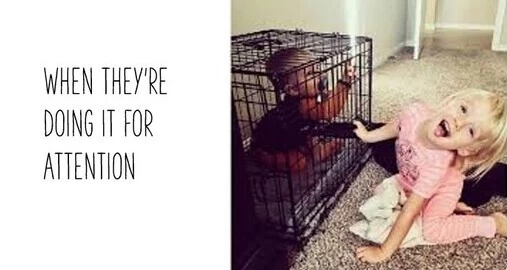
Here is a technique to use to prevent the next round of attention seeking undesirable behaviour. You need to administer a full and strong dose of attention for being good. I recommend they find at least fifty things to acknowledge or praise each day for a week before deciding whether the technique is the right one for their child. This technique is not always fool proof but is worth giving it a try.
Have some fun with them. They will be a lot more reluctant to risk giving up any of that fun because they behaved so badly
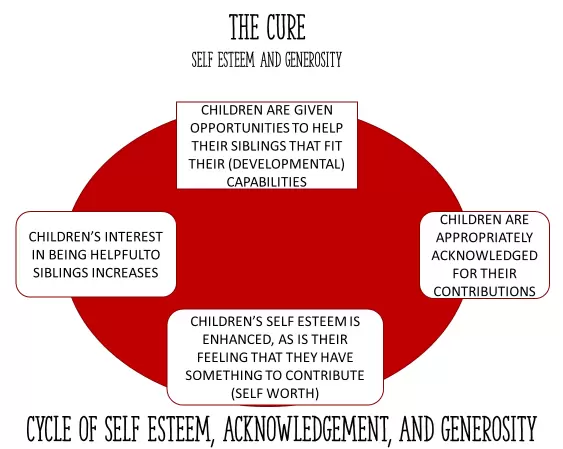
It is important that the opportunities parents provide to children to give to others are consistent with their capabilities, both age related and those that reflect each child’s unique strengths.
- There is no doubt that jealousy over attention from parents can be a major cause of sibling conflicts. That is why it is so important not to compare your children, and why it is so important to help each of your children learn about and develop their own unique talents and abilities.
- Children who are deprived of opportunities to contribute to their family often feel and show just as much anger and rivalry as those who are jealous of what appears favouritism
- Children who have too little opportunity to give something of personal value to their parents may be just as distressed as those who feel that they receive too little from their parents.. In other words parents need to find reasons to feel pride in their children and satisfaction in their own capacities as parents.
- By generosity – I mean the ability to show affection, to give (whether reading a book to a brother